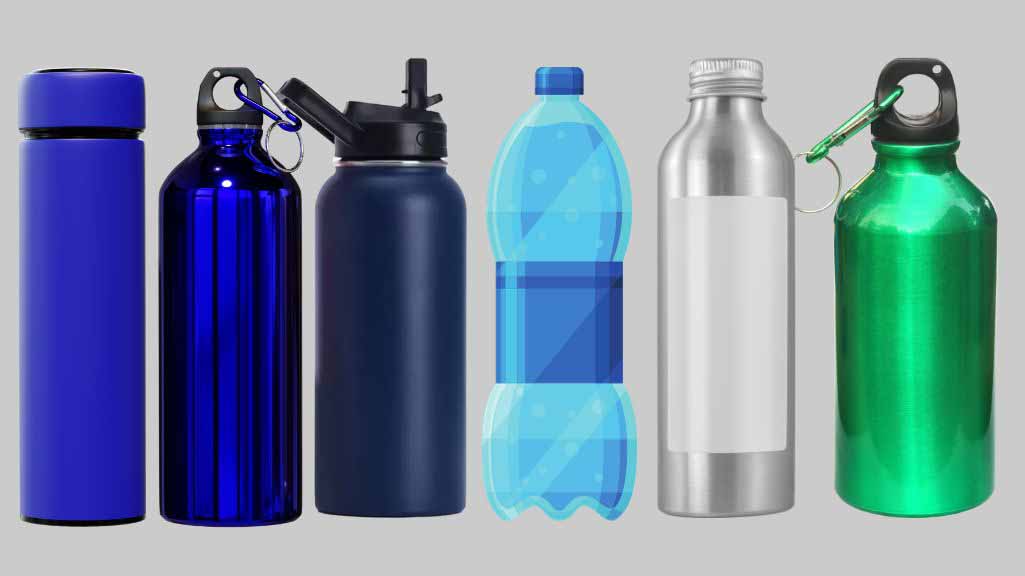Water bottles come in an endless variety, and as society grows more environmentally conscious, the market is getting more and more crowded. While having a wide variety of water bottle materials is fantastic, there are so many possibilities available that it can be challenging to choose the ideal one. But, we have explained the types of water bottles for easy pickup.
Although there are a plethora of materials that may be used to make water bottles, the options have essentially been reduced to the following, which we shall examine in more depth below:
Following are the Types of Water Bottles:
1. Glass Water Bottles
Glass bottles are thought to be the least durable of all the materials that may be used to produce bottles because, well, they break! On the other hand, a lot of brand-new glass water bottles with silicon sleeves have just hit the market, extending the bottle’s lifespan.
It’s also crucial to remember that these water bottles are different from those made of steel or plastic since they can be stored and chilled, making them a wonderful alternative for traveling.
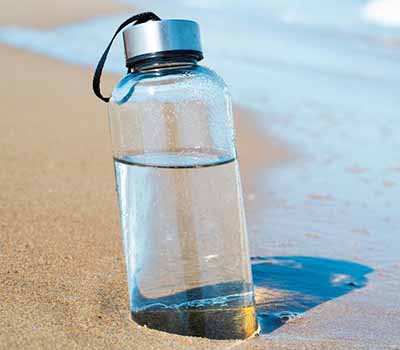
PROS
- Environmentally friendly
- Glass and stainless steel are two of the greatest materials for water bottles.
- Compared to other materials, much simpler to recycle Glass may be recycled indefinitely.
- Aesthetically pleasing and refined
- Wholesome and devoid of any harmful chemical risks
CONS
- Not especially secure
- Not ideal for active or on-the-go use
- Breakable with ease
2. Stainless Steel Water Bottles
Additionally, it is suggested against adding hot water to these bottles since steel conducts heat well and might burn your hands. However, this caution only applies to bottles without an insulating coating inside that helps to preserve the liquid’s temperature.
Although some individuals say they detest the taste of water in steel bottles and the smell of the bottles themselves, there is very little proof that the flavor has changed because these bottles are non-reactive.
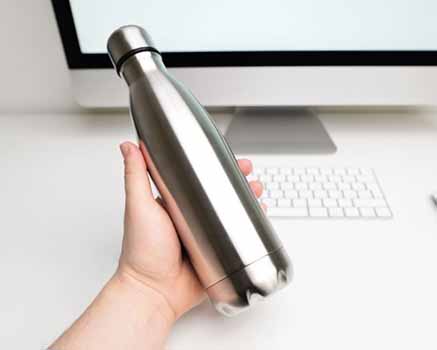
PROS
- Has no effect on drink flavor
- No chemicals or BPAs
- Robust and long-lasting maintains temperature
- Environmentally friendly compared to plastic
- Reusable
- Easy to clean
CONS
- Possibly more expensive initially than throwaway bottles
Recommended: Benefits of Stainless Steel Water Bottles!
3. Ceramic Water Bottles
Ceramic water bottles are not common; however they have been used to store water in the past. Because of their weight and texture, they are not the best material for most people to drink from, but they are good for the environment.
PROS
- Beneficial to the environment and eco-friendly
- Simple to recycle after usage
- Reusable several times
- Create lovely ornamental items for houses.
CONS
- Difficult to get because hardly many businesses sell ceramic water bottles
- Ceramics are not particularly strong at withstanding force and break quickly.
- Unusual “thick” texture that some people find uncomfortable to drink from
4. Plastic Water Bottles
This is the most often used variety of water bottle. Because it is small and light, you can carry it with you everywhere you go.
The effects of plastic on the environment, however, are the main cause for concern. Because it is disposable, the majority of people discard it after using it once. However, there are more durable plastic varieties that are reusable, so those will be a preferable substitute.
Plastic bottles contain endocrine-disrupting BPA, which is dangerous. Thus, be cautious to use BPA-free material, particularly for children’s water bottles.
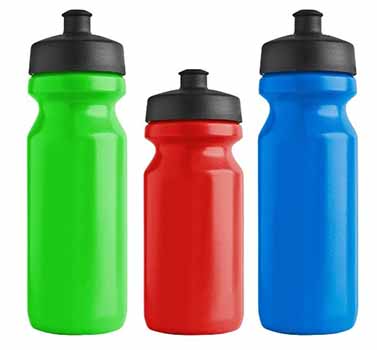
PROS
- Easily shaped
- Cheap to produce
CONS
- Awful for the environment since their rate of creation prevents us from recycling them
- When exposed to heat, BPAs can leach and lead to health problems.
- In addition, BPAs and other chemicals from plastic water bottles have the potential to enter water systems and harm the ecosystem.
- Almost never recycled since they are always in motion
Recommended: Which Insulated Plastic Water Bottle Is Best For You?
5. Copper Water Bottles
Among the most popular materials for water bottles is copper. It is a popular option for those searching for a fashionable water bottle because it is sleek and polished.
Even though copper water bottles have a stylish appearance, you should be mindful of the potential risks associated with them. High copper content water can have adverse consequences, such as vomiting, diarrhea, and nausea.
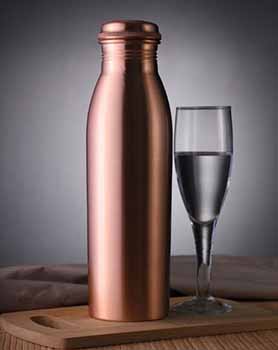
PROS
- Overcome anemia.
- Lower chance of heart disease and cancer.
- Boost your skin’s health.
- Reduce the effects of aging.
- Assist in managing arthritis.
- Lower the risk of infection.
- Aid in losing weight.
CONS
- When ingested in large quantities, copper-infused water can induce nausea, vomiting, and diarrhea.
- Detrimental to human health
6. Bamboo Water Bottles
Bamboo is a sustainable material for water bottles. Its organic and regenerative nature makes it both environmentally and user-friendly. Bamboo is now frequently used to create personalized water bottles with engravings for events like weddings and business gifts.
PROS
- Ecologically favorable
- Ecological viability
- Visually Appealing
- Superior insulating
- Simple to maintain
- Compact and transportable
- Adaptable layout
CONS
- Durability issues
- Receptive to Wetness
- Upkeep is necessary
- Limited range of temperatures
- Not impermeable
- Limited possibilities for capacity
7. Collapsible Water Bottles
If you’re searching for a water bottle that’s convenient to travel with, this is your best option. The bottle is space-efficient since it can be folded when empty.
Think about the materials utilized while selecting collapsible water bottles. Selecting one that is BPA-free is crucial. It should also be durable enough to endure a beating, particularly because you will be folding it.
PROS
- Not heavy
- Portable
- Stackable
- Excellent for trekking or backpacking
- Some are American-made.
CONS
- Made using plastic components
- Most are not as large as conventional hard-shelled bottles.
- Foldable: most struggle to remain upright
- Greater leakage potential is correlated with more seams.
8. Clay Water Bottles
Do you recall the time we used to use earthen pots to drink water? Compared to bottles, the water tastes significantly sweeter and colder. Clay water bottles allow you to enjoy the same kind of water on-the-go, thanks to a few inventive brains.
The porous substance known as terracotta clay, which is burned in fire, is used to make these self-cooling water bottles. It is possible to exclude the possibility of chemicals or hazardous components by purchasing it from a reputable organic brand.
PROS
- Environmentally friendly
- Gives your dining table a more ethnic flavor.
- Have no dangerous substances in it
- No power is needed to cold the water.
CONS
- Heftier than most substances
- Really delicate
- Not extremely simple to maintain
- Unsuitable for use on school or travel
- Costly for something that is handcrafted
9. Silicone Water Bottles
Silicone water bottles are made with Silicone, a flexible and rubbery material primarily made with silica. Food grade Silicone bottles are frees from BPA and harmful toxins and do not leach chemicals into the contents inside.
Collapsible silicone water bottles are very popular with hikers, school going children and travelers as you can adjust the size of the bottle or collapse it when not in case. You can simply put in your pocket or handbag and expand it into a full-size bottle whenever needed.
PROS
- Food grade material
- Light weight
- Contains no harmful toxins
- Unbreakable
- Travel-friendly
- Not very expensive
- Leak proof material
- Stylish looks
- Wide choice of colors
CONS
- Cleaning silicone bottles require some effort
- Poor quality materials can leave a bad taste in your mouth
10. Insulated Water Bottles
Warm or hot liquids can be kept in insulated water bottles for extended periods of time. They are also known as thermos water bottles or flasks because the outside is composed of rubber or plastic and the interior is made of stainless steel.
Double wall insulation and triple wall insulation are your options; in both cases, the inside steel walls are vacuum-separated. For people who want to keep their water cold for extended periods of time, insulated water bottles are ideal.
PROS
- Long-lasting and ideal for travel streamlined styles that fit in a bag, Reusable bottles are environmentally safe, devoid of chemicals and contaminants, and they maintain heat or cold for extended periods of time.
CONS
- Expensive, heavy bottles are not appropriate for use as school water bottles because of their weight and cost. They also cannot be kept in a refrigerator since the outside temperature has no bearing on the temperature of the contents.
Which Other Kinds of Water Bottles Are There?
Examining the many styles available is the next step after learning about the materials you may select. Below are your choices:
Squeeze/Sports
Fitness facilities and teams rely on the simple action of squeezing a sports bottle. Professional athletes frequently utilize the recognizable green and orange squeeze bottles made by Gatorade.
BPA-Free
Scientists are always arguing over the negative impacts of plastic. New findings are also being produced. In any case, to make sure your water is pure and healthful, it’s wise to search for BPA-free water bottles.
Built-In Infuser
A specific area in water bottles with infusers is reserved for fresh fruit, such as raspberries, blueberries, or strawberries. This gives your water a pleasant, revitalizing flavor.
Insulated
Do you wish to sip chilled water all the time? Insulated bottles are a safe choice! If you want your drink to stay colder for longer and have a long day ahead of you, this technique is especially fantastic.
Collapsible
Collapsible water bottles are simple to store in your luggage or backpack since they fold down or roll up. They’re an excellent option for brief outdoor walks or trips.
Eco-Friendly
Carry a reusable water bottle to help the environment. In the long term, reusable plastic drinkware is far better for the environment.
Slim and trim designs are common in stainless steel water bottles. This style’s biggest feature is that it fits perfectly in the cupholder of your automobile!
Wide
Water usually fits into wide bottles better. Certain ones even include measuring lines on the side so you can track your daily intake precisely.
Color Changing
Think about getting a color-changing water bottle if you’re organizing a fundraiser. The youngsters in attendance are going to love these!
Glow in the Dark
Do you need favors for your Halloween gathering? Glow-in-the-dark water bottles are sure to please everyone! Enjoy the cool, glowing look by turning off the lights.
Shaped
A distinctively shaped water bottle is guaranteed to draw attention. One that resembles your favorite character may be found, or you can go for something unusual like balls or lightbulbs.
Digital
Since everything is going digital, it only makes natural that water bottles will also follow suit. An intelligent bottle such as the one seen here monitors your water consumption and degree of hydration.
Health Considerations for Selecting a Water Bottle
When selecting a water bottle, keep the following health aspects in mind:
Material:
As was already noted, some materials, including plastic and aluminum, can contaminate water with compounds that are harmful to human health. Stainless steel and glass are safer materials to use.
BPA-free:
Some plastic items, such as water bottles, contain the chemical BPA (bisphenol A). It has been connected to detrimental health outcomes like hormone imbalance and an elevated risk of several malignancies. If you want to limit your exposure to BPA, look for water bottles without the chemical.
Size:
Make sure the water bottle you choose fits your needs. A larger bottle could be more practical if you want to take it to the gym or on a walk. On the other hand, a smaller bottle can be more useful if all you want is something to keep on your desk at work.
Insulation:
Look for a water bottle with insulation if you want to keep your water hot or cold for extended periods of time. For this, stainless steel bottles work well since they are robust and insulated.
Ease of Cleaning:
Cleaning ease: Selecting a water bottle that is simple to clean will help stop the growth of bacteria and germs. Certain bottles have intricate designs or small apertures that make them challenging to clean effectively.
Leak-proof:
To prevent spills and messes, look for a water bottle that is leak-proof. This is particularly crucial if you intend to carry your bottle with you.
How Do Water Bottles Get Manufactured?
The method of making water bottles involves the following steps:
Raw materials:
Plastic, silicone, glass, stainless steel, and aluminum are some of the materials used to make water bottles. Usually, vendors provide the raw ingredients, which are then transported to the production site.
Molding:
The raw material is melted and then shaped using a mold to take on the required form in the case of silicone and plastic bottles.
• A stamping machine is used to mold the raw material into sheets and then cut them into the correct shape for bottles made of aluminum and stainless steel.
• To make glass bottles, a furnace is used to melt silica sand, soda ash, and other raw ingredients. The molten glass is then shaped using a mold to the required shape.
Assembling:
The bottles are constructed by fitting any required components, including handles, insulation, or caps, after they have been molded or shaped.
Finishing:
Using methods like printing, embossing, or laser etching, the bottles can be adorned or branded with logos or other branding.
Quality control:
The bottles are tested for quality and function and examined for flaws before being distributed to clients.
Packaging and delivery: Following completion, the bottles are packed and sent to stores or clients directly.
Frequently Asked Questions (FAQ)
We addressed a few of the most common queries concerning water bottles.
1. What should I look for in a water bottle?
Consider several important aspects while purchasing a water bottle, including price, weight, style, colors, and patterns as well as cleanliness and sanitation.
In addition, research specifics like the materials used in bottle production, the color dye used in bottle coloring, the composition of the bottle cap, and the presence of BPA in the raw materials.
2. What is the best type and healthiest water bottle to use?
There are several types of water bottles, including glass, stainless steel, plastic, insulated, and foldable models.
Water bottles made of glass are quite expensive. Water does not cause them to respond. Bottles made of stainless steel are long-lasting, non-reactive, and BPA-free. Water in vacuum-insulated bottles stays cold or heated for extended periods of time. These are ideal for journeying.
Collapsible and plastic water bottles are inexpensive, light, strong, and flexible. Using them raises a lot of health and environmental concerns.
3. What’s better: Plastic or stainless steel water bottle?
Like stainless steel bottles, plastic bottles are robust. Compared to stainless steel water bottles, they are less heavy. But BPA is present in plastic.
The health effects of BPA are negative. Heat should be avoided while handling them since it might melt the plastic and react with water to produce BPA chemicals. Reducing the amount of plastic items you use also benefits the environment.
Bottles made of stainless steel are BPA-free. They are incredibly resilient and non-reactive. Stainless steel bottles are definitely superior to plastic ones.
Final Thought
So among 10 types of water bottles, you know everything about each. No water bottle is 100% safe; you have to pick any one as per your safety considerations. If you look at the metal bottles, they have some extra features than plastic bottles. Thinking about environmental safety, avoiding plastic might be a good decision. But, it’s up to you which one to collect for daily use.

